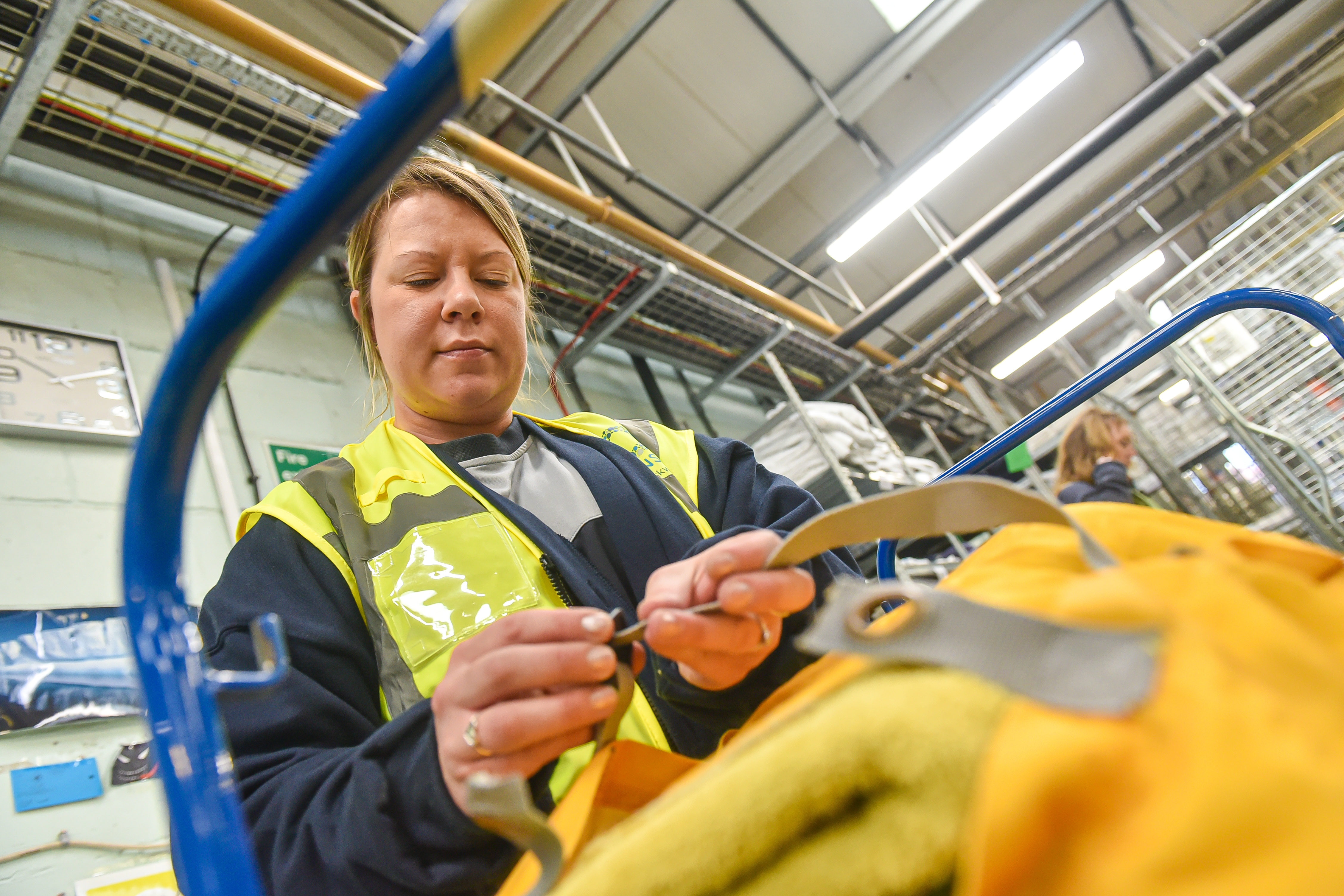When you think of sustainability, commercial laundry probably isn’t the first industry that springs to mind.
With high water and energy usage, extensive transport networks and heavy-duty machinery, it’s easy to assume that sustainability and commercial laundry services don’t go hand in hand. But that assumption is continuing to become increasingly outdated.
Thanks to major technological advancements and smarter, more efficient processes, commercial laundries – like Johnsons Workwear – are making impressive strides in reducing their environmental impact. From laundering processes to deliveries, the industry has been undergoing a quiet but powerful transformation – until now.
With sustainability and ESG (Environmental, Social, Governance) reporting becoming a key focus for many UK businesses, it’s more important than ever to scrutinise every link in the supply chain – even something as deceptively simple as your workwear laundering.
In this article, we explore the key ways in which commercial laundry providers are becoming greener and more efficient, tackling their environmental challenges head-on – and helping customers do the same.
What is commercial laundry sustainability?
Commercial laundry sustainability refers to the environmentally responsible practices used in industrial-scale laundering – from how garments are chosen, cleaned and dried, to the technology, chemicals, packaging, and transport involved. Without sustainable measures in place, the global environmental impact of commercial laundries can be significant – particularly when factoring in fuel for deliveries, single-use packaging and wastewater output.
Common environmental challenges in commercial laundry
When sustainability isn't placed at the heart of operations, the global environmental impact of commercial laundries can be significant. From water and energy waste to emissions and chemical pollution, outdated processes can contribute to long-term environmental harm.
Below, we explore the key challenges when greener alternatives aren't implemented, or even considered:
❌ High water usage
Commercial laundries traditionally require vast amounts of water to clean garments at scale. Without water saving laundry technology in place, this can lead to excessive consumption, strain on local water supplies and increased wastewater output.
❌ Energy consumption
The process of heating water, powering machines, drying garments, and pressing uniforms demands a substantial amount of energy. Without investing in energy-efficient commercial laundry equipment and systems – or even just depending on outdated, poorly-run machinery and infrastructure – laundries risk higher carbon emissions and inflated utility costs, which further compounds their environmental footprint.
❌ Chemical runoff and pollution
Detergents, disinfectants and stain removers are essential for commercial cleaning; but, if not managed properly, they can contribute to water pollution and ecosystem damage. Without modern dosing systems or effective filtration, harmful chemicals can enter watercourses, affecting both human health and wildlife.
❌ Excessive fuel usage
Transport is another essential part of the service, with fleets collecting soiled items and delivering freshly laundered garments from around the country daily. Though, if route planning and fuel efficiency aren’t prioritised, these logistics can become a major contributor to greenhouse gas emissions, with the carbon cost outweighing the benefits of centralised laundering.
❌ Textile waste
Infrequent garment assessments and poor stock management can lead to workwear being over-laundered or discarded prematurely. This contributes to unnecessary textile waste, shortens the lifespan of workwear, and increases the overall environmental burden of a commercial laundry service. Paired with a lack of a sustainable garment recycling scheme, and now this workwear spends its premature end in landfill.
❌ Heat waste
Commercial laundry systems can lose significant amounts of heat during washing and drying cycles. Without modern thermal recovery systems, this wasted energy represents a missed opportunity to improve efficiency and reduce greenhouse gas emissions.
❌ Lack of ESG alignment
When laundries don’t align with wider ESG standards, it can create blind spots in a customer’s supply chain reporting. This disconnect weakens sustainability credentials, especially for businesses that rely on partners to uphold their environmental commitments.
Sustainable laundry practices in commercial laundries
Sustainable commercial laundry goes far beyond swapping out detergent. It’s about rethinking the full lifecycle of workwear – from the wash process to waste, chemicals, packaging, and transport.
Here's a list of ways a commercial laundry can be sustainable, and a quick overview of what to look for in an eco-friendly laundry service:
- Energy and water management
Setting plant-level reduction targets and tracking consumption are key steps any laundry can take towards reducing environmental impact. Data tracking can help drive measurable improvement, in line with wider goals like CCA targets.
- Water-saving technology
Laundries can invest in closed-loop systems that filter and reuse wash water to reduce total water consumption. They also help ensure wastewater meets the correct environmental standards for safe discharge or reuse.
- Optimised washing processes
Sustainable laundries – or even those just looking to optimise for cost – group garments strategically to maximise machine loads and reduce waste. Smaller machines are often used for lesser loads that don’t fit into standard runs.
- Planned preventative maintenance
Routine servicing of washers, dryers and systems helps to prevent leaks and inefficiencies. This reduces unnecessary water and energy use and avoids costly breakdowns.
- Greener chemicals
Eco-friendly laundries can work with suppliers to source non-toxic, biodegradable detergents that are gentler on fabrics and ecosystems. These chemicals are chosen based on garment type to optimise performance, whilst reducing harm.
- Smart dosing
Talking of chemicals – many commercial laundries have automated systems that dispense the exact amount of detergent at the right stage of the wash cycle. This helps to cut down on chemical waste and ensure consistent cleaning results.
- Low temperature washing
Lower temperature wash cycles use less energy without compromising hygiene. Standardised processes, which many laundries have, can ensure this is done consistently and effectively across plants.
- Sustainable workwear
For commercial laundries that also offer workwear rental services, they could consider offering eco-friendly garments made from recycled, responsibly-sourced or biobased fibres. This ensures sustainability from workwear to wash.
- Garment recycling
Workwear should never end up in landfill. There are vast opportunities for commercial laundries to partner with recycling companies to turn old textiles into reusable materials - or donate better quality discarded garments for other purposes.
- Plastic reduction
We are long past the need for laundry to be delivered in single-use plastic. Commercial laundries should look for sustainable – reusable or recyclable – options, such as washable hamper bags.
- Greener transport
Many laundry services optimise delivery routes, monitor fuel efficiency, and invest in low-emission vehicles. These are not just sustainable practices but can save cost and time too.
- Transparency in ESG reporting
Clear and consistent sustainability reporting is essential for building trust. Transparent data sharing – ideally third-party verified – can help commercial laundries avoid greenwashing and align with stakeholder and customer expectations.
- Recognition for sustainability efforts
Sustainable business awards, certifications and accreditations offer trusted, third-party validation of a laundry’s environmental and ethical practices. Recognitions such as the ISO 14001 and EcoVadis showcase commitment to verified sustainable operations and responsible supply chain management.
Is commercial laundry more sustainable than home washing?
Cheap workwear can also have consequences that are less easy to quantify through money.
When it comes to sustainable laundry, the instinctive choice might be to keep things in-house – after all, home washing means no transport, full control and no service fees. But that doesn’t always mean it’s the greener option.
In fact, when comparing commercial laundry sustainability with domestic laundering, professional services often come out on top. Here are some key reasons why outsourcing your workwear laundering could be the more environmentally responsible choice:
✅ Load size efficiency
Commercial laundries process hundreds of garments per cycle, maximising machine capacity and reducing energy and water use per item. Domestic machines, on the other hand, are often underloaded, meaning more cycles are needed to wash the same number of garments.
✅ Water recycling potential
Sustainable professional laundries use advanced water recycling systems that can filter and neutralise wastewater for reuse in subsequent washes. Domestic washing machines lack the infrastructure for water reclamation, so every cycle uses fresh mains water.
✅ Smarter energy use
Commercial laundry services often use low-temperature wash cycles, heat recovery systems, and they maintain equipment to improve energy efficiency and keep costs down. Alternatively, home washing tends to rely on standard pre-set processes, often without optimisation (other than the occasional eco mode).
✅ Controlled chemical use
Many commercial laundries use smart dosing systems that automatically measure and dispense the correct amount of detergent for each load - this reduces chemical waste, protects garments, and prevents overuse. At home, over-dosing or using the wrong detergent is common, which can be wasteful and damaging to fabrics.
✅ Longer-lasting garments
Commercial laundries follow standardised wash processes tailored to specific fabrics and garment types, preserving their performance and extending lifespan. Therefore, proper washing reduces wear and tear, meaning garments need replacing less often – which is better for both cost and the environment. However, home laundering your workwear risks using incorrect temperatures or detergents that can damage the protective properties or shorten its lifespan.
Eco-friendly laundry services from Johnsons Workwear
Choosing the right commercial laundry provider is a crucial part of any business’s sustainability journey.
At Johnsons Workwear, sustainability isn’t just a checkbox – it’s embedded across every stage of our operations, from green commercial laundry equipment and optimised processes to responsible product design and waste reduction.
Backed by recognised environmental accreditations, including ISO 14001, EcoVadis Silver and verified ESG reporting, Johnsons Workwear supports customers in achieving their own environmental goals through reliable, efficient and sustainably driven commercial laundry solutions.
Whether you're looking to reduce your carbon footprint, improve your supply chain transparency or partner with a business committed to doing the right thing – Johnsons Workwear is here to help.
Got a question? Simply get in touch with us today to find out more about the benefits of commercial laundry or explore our rental page for more information.


.png)
.png)

.png)